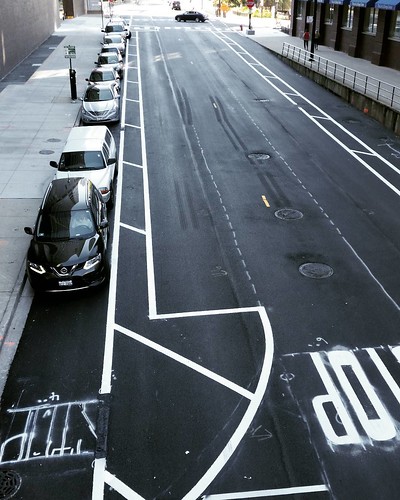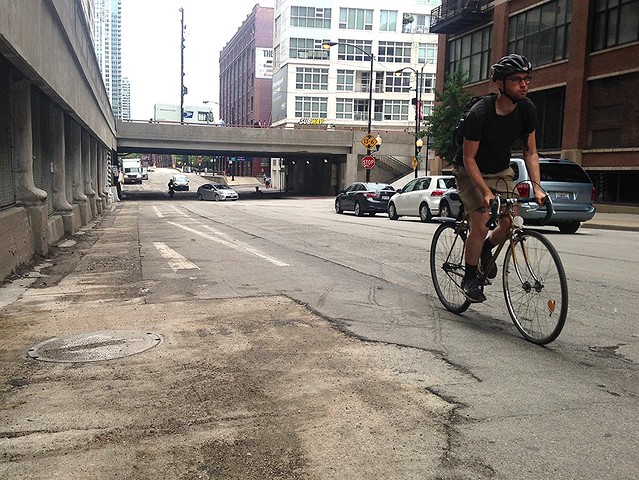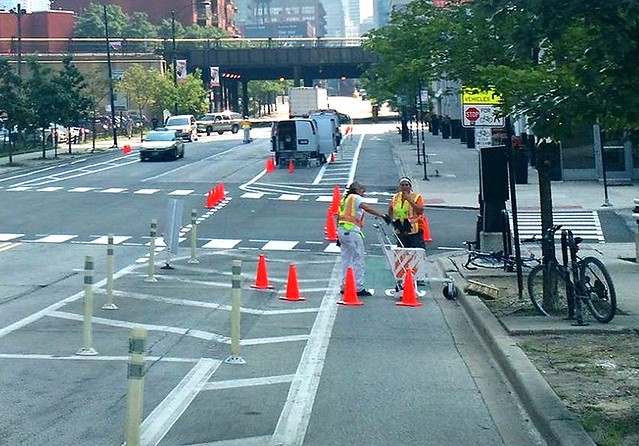
With apologies to The Who, “Meet the new lanes / The same as the old lanes.”
Chicago cyclists have experienced a lot of highs and lows with the Kinzie protected bike lanes. Unfortunately, there’s a new setback. The city has announced the current reconstruction of the lanes won’t involve adding concrete protection, which represents a major missed opportunity to upgrade one of the city’s most popular bikeways. Here’s some history.
In 2011, not long after Mayor Rahm Emanuel took office, the Chicago Department of Transportation installed the lanes, the first protected bikeway in the city, and Kinzie soon became an indispensible bike route, attracting some 4,000 cyclists per day, according to CDOT. It’s the second-busiest biking street in Chicago after Milwaukee Avenue.
In 2013, CDOT agreed to a development plan that called for the developer to pay for installing PBLs on Grand Avenue, Illinois Street, and Wells Street, before the temporary removal of the Kinzie lanes to ease construction of a new high-rise at Wolf Point. However, by early 2015, the new lanes still hadn’t gone in and the transportation department seemed to be unwilling to remove the old ones. That April, Reilly introduced an ordinance to City Council that would have required CDOT to take out the Kinzie lanes, arguing that they conflicted with the Wolf Point construction truck traffic.
In response to Reilly’s move, the Active Transportation Alliance launched a petition asking the other alderman to oppose the ordinance, which garnered more than 1,400 signatures. They also got almost 50 businesses to sign a letter to Reilly asking for the Kinzie lanes to be left in place but improved.
In late 2015, after the pavement, bike lane markings, and flexible posts on Kinzie had deteriorated to the point where the PBLs barely function as such, CDOT crews patched some of the potholes, restriped the marking and reinstalled the bollards. In September the department revealed that they’d struck a deal with Reilly to save the bikeway. “We’ve agreed that the temporary removal of the bike lanes is not necessary at this point in the Wolf Point development, but should be evaluated with future phases of development as part of the traffic study process that is required of the developer,” said spokesman Mike Claffey at the time.
Active Trans applauded the news and called for further improvements, including completely repaving the street, better lighting under the viaducts, and replacing the virtually disposable plastic posts with concrete curbs, or some other type of permanent infrastructure.
Last April, Emanuel cut the ribbon on curb-protected bike lanes on 31st Street by the Illinois Institute of Technology and announced that the city would be shifting its focus to building permanent concrete bike lane infrastructure wherever possible. “CDOT will install curb-protected bike lanes, such as those on 31st Street, where it is practical to do so,” read a statement from the department. “Curb-protected bike lanes provide better separation between people riding bikes and people driving, reduce illegal parking and driving in the bike lane, and improve the aesthetics of the roadway.”
This past year Kinzie gradually became a moonscape again largely due to utility line work. At the same time, important biking streets like Dearborn and Randolph became badly degraded by construction projects. CDOT is currently rebuilding portions of the Dearborn protected bike lane, as well as constructing a new protected lane on Randolph.

The department recently repaved Kinzie and the pavement is now silky smooth, and they’re starting to reinstall the protected lanes. The problem is, it looks like they’re putting the lanes in pretty much the same way as before – without concrete protection. That means that we’re going to see the same old problems with drivers parking in the bike lanes, and the flexible posts being knocked out by careless motorists.
Claffey confirmed that concrete protection isn’t planned. “The Kinzie bike lanes will be reinstalled this fall with improved striping, signage, and green pavement markings,” he stated. “Concrete separation is not included at this stage, however, in order to maintain maximum flexibility during Wolf Point phase II maintenance of traffic to ensure safe and comfortable accommodations for all users of the roadway… We really appreciate that everyone who uses this route is bearing with us while we make these improvements.”
Alderman Reilly did not return calls asking for his perspective on the issue.
The Active Transportation Alliance provided the following statement:
After a long summer with lots of obstructions and uncomfortable riding conditions on Kinzie Street, we are excited to see the resurfacing and reinstallation of Chicago's first protected bike lane.
While the re-installed protected bike lane does not include more permanent elements, such as concrete curb separation or concrete parking end caps, we continue to encourage the city to seek every opportunity to make these improvements to existing protected bike lanes.
We also see an opportunity to think creatively about other methods of separation including planter boxes, which bring the added benefit of beautifying our streets.
At the most recent Mayor's Bicycle Advisory Council meeting in September, CDOT shared that concrete upgrades are already slated for 2017 construction on protected bike lanes on Dearborn, Milwaukee, Harrison, and Elston. We commend the city for its work on these and other upgrades to Chicago's emerging low-stress bike network and are eager to see more improvements like this across the city.
While it’s great that CDOT is planning concrete protection for those streets, it really is a bummer that Kinzie will be returning to the same-old, same-old. Emanuel like to boast in speeches that the Kinzie lanes have helped attract tech companies to the adjacent Merchandise Mart and other River North locations.
It would be great if local business leader were to step forward to lobby Reilly and CDOT to do right by Kinzie by installing curb protection. That strategy proved effective for saving the endangered bikeway last year.
Note: I previously included an extra paragraph of my commentary in the block quote with the Active Trans statement -- I apologize for any confusion this typo caused.





